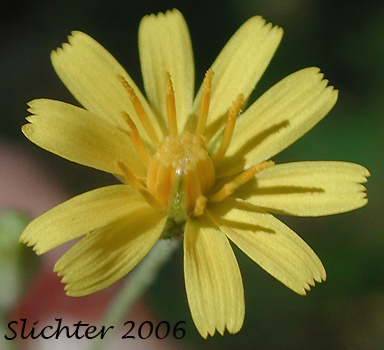 The
photo at right shows a close-up of the flowerhead of smooth hawksbeard as seen
at the Willard Springs Trailhead at the Conboy Lake NWR headquarters.......July
28, 2006.
The
photo at right shows a close-up of the flowerhead of smooth hawksbeard as seen
at the Willard Springs Trailhead at the Conboy Lake NWR headquarters.......July
28, 2006.
Smooth hawksbeard is a weedy annual or biennial with one to several simple to branched, slender stems arising 10-90 cm high from a basal rosette of dandelion-like leaves. The stems and leaves are largely glabrous or are lightly haired with short, yellowish hairs. The thin basal leaves are broadly oblanceolate with dentate margins with narow, divergent teeth or pinnatifid or pinnately parted margins (See photo below.). The blades are glabrous and measure 8-25 cm long and 5-45 mm wide and have short winged petioles. The few stem leaves are similar to those of the base but are reduced in size upwards on the stem (See photo below.) The uppermost leaves become sessile with clasping, auriculate bases.
The inflorescence is open and branched with numerous flower heads (See photo below.) Individual flower heads consist of 20-60 individual flowers. The involucre is narrowly bell-shaped with individual bracts linear-lanceolate in shape with acuminate tips. It measures 7-9 mm high and is covered with minute hairs and a few gland-tipped bristles. The ligules are 5-7 mm long and the plumed pappus is longer than the achene.
Smooth hawksbeard is a plant of dry, open disturbed places in the foothills and plains. It is common in gravel parking lots, along roads, quarries and fallow fields.
Native to central and southern Europe, smooth hawksbeard is found from southern British Columbia south through western Oregon and Washington to California. It can be found sparingly east of the Cascade Mts.